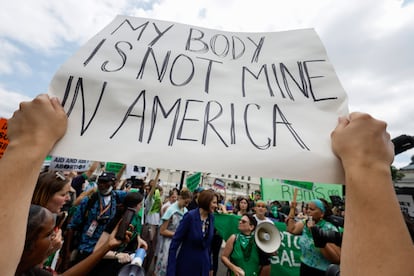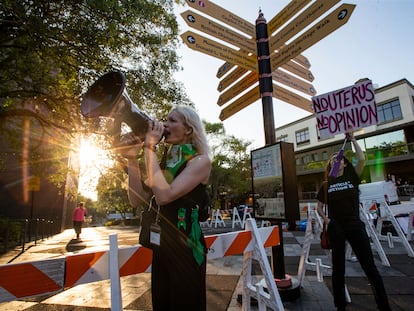A fractured country: One year after US Supreme Court overturned ‘Roe v. Wade’
More than 25 million women between the ages of 15 and 44 live in states where the conditions for terminating a pregnancy have become stricter after landmark ruling

When on June 24, 2022, the Supreme Court struck down the federal right to abortion in the United States in a vote of six to three, what it did was to return the power to legislate to each of the country’s 50 states. The ruling, which overturned the half-century-old precedent of another high court decision, the landmark Roe v. Wade (1973), has left behind a changing patchwork map for women’s reproductive health rights. That mapping is also a true reflection of a polarized society.
At least 25 states, almost all of them governed by the Republican Party, have since decided to prohibit or severely restrict abortion rights, while in other parts of the country with Democratic leanings such as Colorado or California, that protection has been strengthened. Meanwhile, the legality of mifepristone, a drug that is used in about half of all abortions performed in the United States, is in question following a ruling by a federal judge in Texas.
In post-Roe America, more than 25 million women between the ages of 15 and 44 live in states where conditions for abortion have been tightened, according to the Associated Press, in the 12 months since the Supreme Court - the most conservative in eight decades - handed down Dobbs v. Jackson Women’s Health Organization, a case that has also been enshrined in American legal history textbooks. More than 5.5 million women reside in places whose politicians have made decisions in that same restrictive direction, but which are on hold while they are challenged in court by associations such as Planned Parenthood (PP), which operates about half of the country’s abortion clinics. The PP is behind the complaint that paralyzed the entry into force of a Utah law, which was ready pending the Supreme Court’s ruling. Utah’s is just one of about 50 cases open in the courts after Roe was overturned.

In the other half of the country, abortion remains legal up to at least the first 24 weeks of pregnancy. In 20 states, from Kansas to Minnesota, those protections, suddenly challenged after half a century, have been consolidated by law or incorporated as an amendment to their constitutions after a vote at the ballot box.
Geographically, the ruling has shaped a map in which vast regions of the South and Midwest have become a “desert for women’s rights,” in the definition of Isabel Guarneri of the Guttmacher Institute, a non-partisan organization of reference in the relationship between reproductive health and public policy.
That desert is close to extending its silhouette to encompass almost the entire Southeastern United States, if two contested laws go into effect in Florida and the two Carolinas, which would lower the limits for abortion. In South Carolina there is a law with a six-week time limit; it has been blocked by a judge and is awaiting review by a conservative state Supreme Court. In North Carolina, a rule banning terminations after 12 weeks is scheduled to take effect on July 1.
There are oases in this desert, such as Illinois and Kansas, where a referendum in August protected women’s freedom of choice, but these are surrounded by states where abortion is not an option. One of the most immediate consequences of the Dobbs ruling was that it generated an exodus of patients who were forced to travel hundreds or thousands of miles to terminate their pregnancies, making abortion a right now also determined by geographic and economic factors.
Politically, it has proved to be a more complex issue than anti-abortion organizations had anticipated over the past 40 years, during which time they applied political and judicial pressure to force the Supreme Court - with three judges appointed during the Donald Trump administration with the express mission of overturning Roe - to adopt a decision favorable to their struggle.
Last November’s legislative elections demonstrated the political weight of abortion. Women’s reproductive health was a decisive electoral argument to stem the “red wave” anticipated by the Republicans. President Joe Biden has underlined the threats to reproductive health during his reelection campaign. Candidates for the Republican nomination for the 2024 presidential election - a crowded, unfinished slate that is comfortably led by Trump - are demonstrating in the early stages of the campaign that they have learned their lesson and have generally avoided speaking out explicitly on a hugely divisive issue.
The aspirations of Trump’s greatest rival, Florida Governor Ron DeSantis, are being harmed by the fact that in April he signed one of the most restrictive laws in the country, which set the deadline for abortion at six weeks with exceptions for pregnancies involving rape or incest, which will be permitted until 15 weeks of pregnancy provided documentation such as a restraining order or police report can be produced.
When Roe was overturned, polls showed two-thirds of the United States was against tightening the conditions for terminating a pregnancy. A poll commissioned by NBC News this week put the percentage of Americans who disapprove of the Supreme Court’s decision a year ago at 61%. According to an aggregate of polls published Friday by The New York Times, for the first time, a majority of Americans consider abortion “morally acceptable” and the new abortion laws that have gone into effect this year “too strict.”

Perhaps the best example of how women’s right to choose has become one of the most divisive issues in the U.S. for half a century is provided by one of the most extreme: Alabama Congressman Tommy Tuberville blocked the promotions of approximately 200 high-ranking military personnel in key U.S. defense regions because of the Pentagon’s permissive abortion policy, which allows its employees to take a few days off to have an abortion and guarantees reimbursement of expenses for those who need to travel. Both are a pipe dream for most low-skilled female employees in the U.S. In states like Texas, these financial impediments are compounded by criminal penalties: a person who agrees to an abortion faces up to five years in prison under a law passed in September 2021.
This cascade of prohibitionist regulations has lowered the number of abortions being carried out: according to the monthly estimate made by the #WeCount survey, which collects data from clinics across the country, 25,650 fewer abortions were performed in the United States in April 2023 than in the same month a year earlier, when Roe was still in place.
The next target of the U.S. anti-abortion movement is a ban on mifepristone, the most popular abortion drug, in combination with another pill, misoprostol. The former terminates pregnancy; the latter empties the uterus.
In January, a change in Food and Drug Administration (FDA) rules allowed the sale of these pills in retail pharmacies. Matthew Kacsmaryk, a federal judge appointed by Trump, temporarily halted the administration of the former in April. In practice, that decision never went into effect. The same nine Supreme Court justices who last June overturned Roe went against the opinion of a New Orleans appeals court, whose justices set restrictions on the administration of mifepristone while reviewing the ultraconservative Kacsmaryk’s ruling.
That ruling by the U.S. Supreme Court was a rare victory for the pro-abortion movement in the country, although it did not dispel the specter that these drugs will eventually be banned nationwide. The ruling that overturned Roe v. Wade a year ago has also had consequences for the high court. The May 2022 leak of its draft plunged the institution into an unprecedented crisis that, with the source still unidentified, is far from over. The credibility of the Supreme Court, whose members are elected for life, has also been undermined in the eyes of U.S. citizens. According to a recent Gallup poll, nearly 60% of Americans disapprove of their judgment, considering it partisan and too conservative. This represents an all-time high.
The text of the leaked Supreme Court draft opinion stated that the Roe precedent “was egregiously wrong from the start,” because abortion is not a right under the U.S. Constitution. In one of the concurring opinions, Justice Clarence Thomas wrote the court “should reconsider” all previous rulings, in reference to cases brought under the Fourteenth Amendment, which protects, among other rights, that of privacy. These include Obergefell v. Hodges (2015), which legalized same-sex marriage; Lawrence v. Texas (2003), which ended the ban on same-sex relationships (2003), and Griswold v. Connecticut (1965), which allowed married couples to use contraception.
So far, that fear of progressive activists that the path taken a year ago by the court will continue has not materialized. Instead, in places dominated by the Republican Party, conservatives have made progress in passing laws limiting the rights of trans people in at least 19 states. In many cases, this new crusade (no such law existed at the beginning of 2021, but it already promises to become one of the main battlegrounds of next year’s presidential election) is posed as complementary to the restriction of women’s reproductive rights.
Sign up for our weekly newsletter to get more English-language news coverage from EL PAÍS USA Edition
Tu suscripción se está usando en otro dispositivo
¿Quieres añadir otro usuario a tu suscripción?
Si continúas leyendo en este dispositivo, no se podrá leer en el otro.
FlechaTu suscripción se está usando en otro dispositivo y solo puedes acceder a EL PAÍS desde un dispositivo a la vez.
Si quieres compartir tu cuenta, cambia tu suscripción a la modalidad Premium, así podrás añadir otro usuario. Cada uno accederá con su propia cuenta de email, lo que os permitirá personalizar vuestra experiencia en EL PAÍS.
¿Tienes una suscripción de empresa? Accede aquí para contratar más cuentas.
En el caso de no saber quién está usando tu cuenta, te recomendamos cambiar tu contraseña aquí.
Si decides continuar compartiendo tu cuenta, este mensaje se mostrará en tu dispositivo y en el de la otra persona que está usando tu cuenta de forma indefinida, afectando a tu experiencia de lectura. Puedes consultar aquí los términos y condiciones de la suscripción digital.
More information
Archived In
Últimas noticias
Most viewed
- Sinaloa Cartel war is taking its toll on Los Chapitos
- Oona Chaplin: ‘I told James Cameron that I was living in a treehouse and starting a permaculture project with a friend’
- Reinhard Genzel, Nobel laureate in physics: ‘One-minute videos will never give you the truth’
- Why the price of coffee has skyrocketed: from Brazilian plantations to specialty coffee houses
- Silver prices are going crazy: This is what’s fueling the rally










































